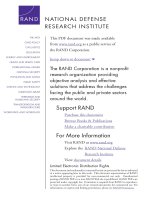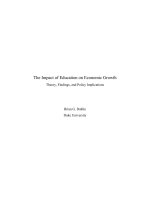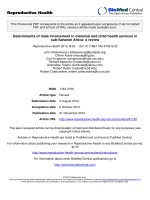2007 Environment Policy Review potx
Bạn đang xem bản rút gọn của tài liệu. Xem và tải ngay bản đầy đủ của tài liệu tại đây (4.05 MB, 148 trang )
2007
Environment Policy Review
ISSN 1831-1946
2007
Environment Policy Review
Communication from the Commission
to the Council and the European Parliament
COM(2008)409
Europe Direct is a service to help you find answers
to your questions about the European Union
Freephone number (*):
00 800 6 7 8 9 10 11
(*) Certain mobile telephone operators do not allow access
to 00 800 numbers or these calls may be billed.
Photo credits:
2008, Jupiterimages Corporation page 15, 16, 37; DigitalVision/GettyImage,
pages 11, 83, 92, 95, 98, 142, 145; European Communities, pages 5, 10, 14, 33, 68, 71,
77, 80, 110, 118, 121, 127, 130, 139; European Communities/EPA Photo/Antonio Bat,
page 136; European Communities/EPA Photo/CTK/Samuel Kubani, page 133;
European Communities/EPA Photo/EPA/Janek Skarzynski, page 124; European
Communities/EPA Photo/NIPA/Aivar Partel, page 86; European Communities/
EPA Photo/Petras Malukas, page 113; ont.lu, page 115; Photodisc/GettyImage,
pages 9, 12, 17, 18, 25, 29, 34, 74, 89, 101, 104, 107; Phovior, cover, page 26
More information on the European Union is available on the Internet
().
Luxembourg: Office for Official Publications of the European Communities, 2008
ISBN 978-92-79-09384-5 (printed version)
ISBN 978-92-79-09564-1 (web version)
© European Communities, 2008
Reproduction is authorised provided the source is acknowledged.
2007 Environment Policy Review — 3
Table of contents
Foreword by Commissioner Stavros Dimas 5
Introduction 7
A number of decisive steps were taken in 2007 9
The policy framework is now in place 9
New financial instruments set in motion 10
Better regulation now central to environmental policy-making 11
More integration of environment into other policies 11
EU international leadership on environment policies confirmed 13
EU environment policy has increased legitimacy 14
But to face global challenges in 2008 and after, new impetus is needed… 15
Further strengthening implementation 15
Continued effort to simplify and improve policies and instruments 16
The key challenges ahead 17
Conclusions 20
Annex 21
Introduction 23
Part 1: Achievements, new findings and outlook
in the 6
th
Environment Action Programme priority areas 25
Climate change 25
Nature and biodiversity 28
Environment and health 31
Natural resources and waste 34
Better regulation in environment policy 36
Part 2 - Statistical data 39
Climate change and energy 40
Nature and biodiversity 47
Environment and health 53
Natural resources and waste 56
Environment and the economy 59
Implementation 60
Indicators “Beyond GDP” 61
4 — 2007 Environment Policy Review
Austria 66
Belgium 69
Bulgaria 72
Cyprus 75
Czech Republic 78
Denmark 81
Estonia 84
Finland 87
France 90
Germany 93
Greece 96
Hungary 99
Ireland 102
Italy 105
Latvia 108
Lithuania 111
Luxembourg 114
Malta 116
The Netherlands 119
Poland 122
Portugal 125
Romania 128
Slovakia 131
Slovenia 134
Spain 137
Sweden 140
United Kingdom 143
Part 3: Commission summary of environment policy actions in
the Member States 65
2007 Environment Policy Review — 5
Foreword by
Commissioner Stavros Dimas
Europe’s environment policies have brought
immense benefits to Europe’s citizens. Their
air is purer, their beaches and rivers are
cleaner and pollutants such as lead in petrol
have been banned. By allowing countries
to work together and solve problems that
cross national borders, our environment
policy is one of the greatest success stories
of European integration. A recent survey
showed how much popular support EU
environment policy enjoys: 96% of Europeans attach a high importance to protection of the
environment and consider that it has a great impact on their quality of life. These figures are
very encouraging, and they underline the heavy responsibility we bear.
This Environment Policy Review reports on the progress we made last year and points to
the challenges ahead. And one of the main conclusions of the review was that 2007 proved
to be a turning point in EU environment policy as all the main commitments under the 6
th
Environment Action Programme have now been delivered.
Despite the good progress there is a lot of challenging work that remains to be done. Member
States must step up their efforts to implement EU environment legislation. As we start moving
towards a low-carbon economy, we must also start looking towards a low-resource economy.
Our current patterns of consumption are not sustainable and are at the root of many of the
environmental problems we face – from the ever-increasing amounts of waste we generate,
to the two greatest environmental challenges: biodiversity loss and climate change. An impor-
tant step forward was the adoption of the Sustainable Consumption and Production and Sus-
tainable Industrial Policy Action Plan in July 2008, but there is still a long way to go.
The work carried out over the next two years will be critical if we are to meet our envi-
ronmental objectives. On climate change we will be moving towards agreement at the
Copenhagen conference at the end of 2009. Improving implementation of all our EU
environment legislation will be a key priority. And we will need to intensify our efforts
to achieve the objective of halting biodiversity loss by 2010. Furthermore, measures to
implement the package of actions for sustainable consumption and production will need
to be put in place. I intend to use the remaining time under this Commission’s mandate
to make further advances in meeting all these environmental challenges and I know I shall
have the support of Europe’s citizens.
2007 Environment Policy Review — 7
Introduction
The year 2007 marked a turning point in EU environment policy. The main commitments
under the 6
th
Environment Action Programme 2002-2012 (6
th
EAP) have been delivered
as demonstrated by its mid-term review and we must now further strengthen our efforts
on implementation.
Environment issues are now firmly at the top of the political agenda, and command the
attention of decision-makers, the media and the public. 80 % of EU citizens find the envi-
ronment important for the quality of their life. A good example is climate change, particu-
larly since the endorsement of the energy and climate change package in March 2007
by European Heads of State and Government. Instruments have been fine-tuned where
possible under the Better Regulation exercise. Externally, the EU has kept the lead on envi-
ronmental issues, backed up by solid achievements at home and by good bilateral and
multilateral relations with key partners. In global negotiations it has secured significant
advances in several areas, notably on climate in the Bali conference.
We need, however, to prepare for the major challenges ahead: defining a long-term stra-
tegic vision for sustainable consumption and production, adaptation to the inevitable
climatic changes, and the protection of biodiversity. We should take advantage of the
relatively light legislative calendar in 2008 and 2009 to advance now on these issues.
At the international level, we face demanding negotiations to secure future international
agreements on climate, and to preserve and manage biodiversity.
2007 Environment Policy Review — 9
A number of decisive steps
were taken in 2007
The policy framework is now in place
First and foremost, the energy and climate change package endorsed by the European
Council in 2007 firmly set Europe on the path to a low-carbon economy.
The EU committed to a 30 % reduction in greenhouse gas emissions provided there is
an international agreement. But even if there is no agreement it promises a unilateral
reduction of at least 20 % by 2020. It set targets of 20 % for energy from renewable
sources and 10 % for biofuels in transport. In January 2008, the Commission translated
the commitments into concrete action by adopting a Climate Action and Renewable
Energy implementation package. This included proposals for (a) an improved Emissions
Trading Scheme (ETS), (b) sharing the effort in non ETS-sectors like road transport, build-
ings, services and agriculture, (c) a Directive with legally enforceable targets for renewable
energy including a set of sustainability criteria for biofuels, (d) new Community guidelines
on state aid for environmental protection and (e) a regulatory framework to ensure that
Carbon Capture and Geological Storage technologies are used safely. As the increased
production of biofuels is one of the causes of recent food price rises around the world,
the Commission will monitor the environmental and social impacts of the policy and, if
appropriate, propose corrective action.
In other policy areas too, the Commission has delivered almost all its main commitments
under the 6
th
EAP. All seven of the thematic strategies (air, waste prevention and recy-
cling, marine environment, soil, pesticides, natural resources and urban environment)
have been presented to the co-legislator. Accompanying legislative proposals have been
adopted or are being examined by Council and Parliament.
Other major initiatives were also launched. The Commission presented a proposal for a
new Industrial Emissions Directive, which merges and revises the Integrated Pollution
Prevention and Control Directive and six other
sectoral directives. This tightens emission limits
in certain sectors, sets standards for environ-
mental inspections and extends the scope to
medium-sized combustion plants. The long
awaited REACH - Registration, Evaluation,
Authorisation and restriction of Chemicals –
regulation, reforming the way we deal with
chemicals, was adopted and the European
Chemicals Agency started operating. Also
10 — 2007 Environment Policy Review
the Environmental Liability Directive came into force. These key pieces of legislation form
the basis for sustainable industry in Europe.
On resource management, agreement was reached on a Marine Strategy Framework
Directive, whereby Member States have to do what is necessary to achieve good envi-
ronmental status in the marine environment by 2020. A new waste shipment law applies
since July, including a ban on exports of hazardous waste to developing countries.
However, progress was not uniform in all sectors. For instance, the Commission regrets
that the Council did not reach a political agreement on the proposal for a Soil Framework
Directive.
The mid-term review of the 6
th
EAP confirmed the main priorities of the Programme - cli-
mate change, nature and biodiversity, environment and health, and natural resources and
waste - and took stock of progress. It noted that the EU is not yet on the path towards sus-
tainable development; its policies - if fully implemented - will only yield results over time
as pressures on the environment continue to grow; further efforts are needed. This assess-
ment, as far as climate and energy are concerned, was also confirmed in the progress
report on the renewed Lisbon Strategy for Growth and Jobs.
New financial instruments set in motion
The financial instruments for environment policy under the current multiannual financial
framework became operational in 2007: LIFE+, agreed in March 2007 by the Council and
Parliament with a budget of € 2 143 million for 2007-13, will provide funding for all four prior-
ity areas of the 6
th
EAP, 50 % of the funds being earmarked for nature and biodiversity.
The first out of three instruments envisaged under the Competitiveness and Innovation
Framework Programme for support to eco-innovative small and medium-sized enterprises
(SMEs) was launched in 2007. € 228 million is earmarked for eco-innovation in 2007-13.
The Commission also launched the Thematic programme on environment and sustain-
able management of natural resources, including energy, with an initial € 889 million
budget for 2007-13, to address the environmental dimension of development and other
external policies and to promote the EU’s envi-
ronment and energy policies abroad. In 2007,
€ 74 million has been earmarked to environ-
mental projects. Support for environmental
policy is also provided through external finan-
cial instruments that became operational
in 2007, i.e. the Development Cooperation
Instrument, the European Neighbourhood
and Partnership Instrument and the Instru-
ment for Pre-Accession Assistance.
2007 Environment Policy Review — 11
The Civil Protection Financial Instrument adopted by the Council in 2007 with a budget
of € 189.8 million for 2007-13, will provide funding for all EU activities in the field of civil
protection.
Better regulation now central to environmental
policy-making
Whenever possible and opportune, efforts
to simplify legislation have continued. For
instance, the Commission’s proposal for a new
Industrial Emissions Directive offers a clearer
and coherent legal framework for industry
and should cut administrative costs. Another
Commission Decision adopted in 2007 will
clarify ETS monitoring and reduce reporting
requirements for low-emitting installations.
The Commission also presented a Green
Paper on market-based instruments to
stimulate a discussion on ways to further promote their use at
Community and national level, as they often are the most cost-effective way of meeting
environmental objectives.
Better regulation requires a sound knowledge base for assessing the driving forces, pres-
sures, state and impacts on the environment. With the entry into force of the INSPIRE
Directive the EU has taken a major step forward in assuring that relevant spatial data can
be found, accessed and shared.
The Commission continues to conduct impact assessments of all its major policy pro-
posals. 2007 was the first full year of operation of the Impact Assessment Board which
scrutinises these assessments.
More integration of environment into other policies
Further integration reflects the growing consensus that the fight against climate change
needs to be factored into most policy areas. Indeed, the 4
th
assessment report of the
Intergovernmental Panel on Climate Change confirmed that the warming of the climate
system is unequivocal and that impacts may be severe, requiring action in many policy
areas. Partly to address this issue, there was progress on integrating environment into
transport. This is one of the most difficult issues in the fight against climate change and
other pollution. In 2007 the Commission proposed a legislative framework to achieve the
2012 target of 120 g/km CO
2
emissions for new cars while new standards (Euro 5 and 6)
12 — 2007 Environment Policy Review
setting tighter limits on emissions of particles and nitrogen oxides were formally adopted
by Council and Parliament. The Commission also proposed new emission norms for heavy
duty vehicles (Euro VI) which - once adopted - will bring cleaner trucks and buses. The
proposed revision of the Fuel Quality Directive will cut sulphur levels and reduce pollutant
emissions as well as the greenhouse gas intensity of fuels on a lifecycle basis. The Direc-
tive on ambient air quality and cleaner air, adopted in April 2008, will reduce exposure
to small particles (PM
2.5
) in urban areas. The Commission also adopted a Green Paper on
urban mobility and launched a public consultation on follow-up actions, which will be
presented in an Action Plan on urban mobility in autumn 2008. Further, it proposed a
Directive to introduce environmental aspects into public procurement of vehicles.
Integration also progressed in other fields.
Agriculture: While the Common Agricultural Policy (CAP)
includes a series of instruments contributing to the pro-
tection of the environment and nature conservation (e.g.
decoupling, cross-compliance, agri-environment and Nat-
ura 2000 payments), in 2007 the Commission approved 57
of the 94 rural development programmes for the period
2007-13, corresponding to a budget of € 68 billion. Nearly
half of this budget will go to measures for “Improving the
environment and the countryside”.
Cohesion policy: The Commission by end 2007
adopted almost all Operational Programmes of the
Member States, earmarking € 347 billion for 2007-13.
Around 28 % of these funds are planned for investment
in environmentally related projects and infrastructure,
mainly for sustainable transport (around € 34 billion) and water (around
€ 22 billion), besides that i.a. for renewable energies and energy efficiency, waste manage-
ment, risk prevention, nature protection and clean technologies.
Development: The Commission continued to build progressively sustainability concerns
into its development cooperation agreements both by focusing on specific environmental
themes and by integrating environment across all development cooperation activities.
Health: The Mid-term review of the Action Plan on Environment & Health 2004-2010
demonstrated that cooperation between environment policy, health policy and the cor-
responding research fields has been strengthened.
Industrial policy: The Commission announced in the Mid-term Review of the Industrial
Policy its intention to promote the opportunities that environmental challenges, if prop-
erly managed, represent for European firms. It will back this up by actions on sustainable
industrial policy, consumption and production.
2007 Environment Policy Review — 13
Research: The Commission continued to integrate environmental sustainability in its
Research Programmes. In the 7
th
Framework Programme for 2007-13, the Environment
and Energy themes (with budgets of € 1 890 million and € 2 350 million) support environ-
ment policy development and implementation, including research on energy and cli-
mate change issues.
Trade: The Commission actively pursued the inclusion of sustainable development chap-
ters in the regional and bilateral free trade and association agreements it is negotiating in
different parts of the world. Work on this is partly guided by the trade-related Sustainable
Development Impact Assessments that the Commission does before concluding free
trade agreements.
EU international leadership
on environment policies confirmed
Domestic environment policy initiatives underpin the EU’s efforts to promote high envi-
ronmental standards worldwide. International negotiations on climate change in 2007
culminated in the decision in Bali to work intensively towards a comprehensive global
agreement for effective action after 2012 and to conclude negotiations in 2009. The EU´s
aim is to reach an agreement on binding absolute emission reduction targets for devel-
oped countries and on enhanced contributions by developing countries, especially newly
industrialising countries.
Progress was also made in other fields. The 14
th
Conference of the Parties to the Conven-
tion on International Trade in Endangered Species agreed on a nine-year moratorium on
ivory sales after a one-off sale of government-owned stocks of raw ivory. To guarantee the
legality of forest products imported into the EU from signatory countries, the Commis-
sion launched formal negotiations towards voluntary partnership agreements on Forest
Law Enforcement Governance and Trade with Indonesia, Ghana and Cameroon, and con-
tinued negotiations with Malaysia. Together with UNEP, the Commission established the
International Panel for Sustainable Resource Management to provide authoritative sci-
entific advice on resource management to policy-makers globally. The Commission also
continued discussions with candidate countries and potential candidates to support their
gradual alignment with EU standards and to prepare for future accession negotiations.
Dialogue and cooperation on environmental issues were enhanced with partner coun-
tries within the European Neighbourhood Policy and the EU-Russia Strategic Partnership.
14 — 2007 Environment Policy Review
EU environment policy has increased
legitimacy
The latest Eurobarometer survey on the attitudes of Euro-
pean citizens carried out at the end of 2007 confirms
the popular support EU environment policy enjoys. In
virtually every Member State, respondents prefer deci-
sions about protecting the environment to be made
jointly within the EU (67 %) rather than at national level.
They see harmonised European legislation as necessary
(82 %), believe that the EU should extend assistance to
non-EU countries to help them improve their environ-
mental standards (80 %) and would accept that the EU
allocates more money to environmental protection even at
the expense of other areas (78 %).
The new Treaty of Lisbon signed in December 2007 reinforces the EU’s capacity for action.
It explicitly introduces climate change into EU environment policy and recognizes that
the EU has a leading role to play in fighting it on the international scene. It also pro-
vides a clearer legal basis for EU action on energy and civil protection, stressing solidarity
between Member States.
2007 Environment Policy Review — 15
But to face global challenges
in 2008 and after, new impetus
is needed…
Despite these advances we cannot relax our efforts; firstly because advances will materi-
alise only if fully implemented, and secondly because the challenges ahead of us call for
even stronger action. This was highlighted in the first progress report of the EU’s Sustain-
able Development Strategy.
Further strengthening implementation
While the policy framework and most measures are in place, implementation of EU envi-
ronment legislation by Member States is often slow or incomplete. At the end of 2007,
there were 479 open infringement cases - 22 % of the EU-total - concerning EU envi-
ronment legislation. A majority of cases concern bad application of EU environment law,
but there are also cases concerning lack of transposition or improper transposition of
directives.
The Commission continued to take action to improve implementation, following a twin-
track approach of both support measures and sanctions. It has put forward cross-cutting
proposals including better information, help with problem-solving, increased transpar-
ency and more efficient management of infringements cases. Awareness raising events
were organised on different issues across Member States, notably on the Waste Shipment
Regulation and the Landfill Directive because of the large implementation gaps and the
potentially severe environmental impacts. The Commission proposed an Environmental
Compliance Assistance Programme in order to help small and medium-sized enterprises
through training, technical advice and strengthening support networks.
The Commission also started legal action
against several Member States for not properly
implementing or transposing key environ-
ment legislation. In addition, a proposal for a
directive was presented, which aims to ensure
that serious environmental offences are sub-
ject to criminal sanctions across the Member
States.
In 2008 the Commission will step up its
efforts to support Member States and their
16 — 2007 Environment Policy Review
authorities on implementation through better information exchange, guidance and train-
ing. EU external assistance programmes will continue to provide financial and technical
support to partner countries to help them align their environment policy with the EU
acquis, particularly the candidate countries and potential candidates. The Commission
has also decided to present a Communication to outline the means that we can use to
prevent breaches of environmental law and to set out criteria for identifying infringement
cases which need most immediate and intensive Commission legal action. It will further
review the 2001 Recommendation on minimum criteria for environmental inspections.
Finally, an integrated communication campaign will be launched mid-2008 to raise aware-
ness among stakeholders and the general public and to ensure maximum support to all
key policies and initiatives.
Continued effort to simplify and improve policies
and instruments
As environment policy and its integration into other policy areas are becoming increas-
ingly important we must work continuously to maximise its efficiency, cost-effectiveness
and transparency. The Commission will thus continue to apply Better Regulation princi-
ples here.
To this end the Directive on Waste Electrical and Electronic Equipment and the Directive
on the Restriction of the use of certain Hazardous Substances in electrical and electronic
equipment will be revised in 2008. The Regulation on substances that deplete the ozone
layer will be updated and simplified. The Ecolabel and EMAS (Environmental Manage-
ment and Auditing System) schemes will be revised to improve procedures and reduce
administrative burdens for participating companies. The Commission and the European
Environment Agency (EEA) have jointly developed the Water Information System for
Europe (WISE) which should cover all reporting under water directives by 2010. The
Commission will also further develop the Shared Envi-
ronmental Information System (SEIS), and strengthen
the GMES (Global Monitoring for Environment and
Security) programme.
Reports on the Environmental Impact Assessment
and Strategic Environmental Assessment Directives
show that the greatest scope for improving efficiency
lies with Member States. The Commission is preparing
guidance to resolve outstanding interpretation issues
and increase consistency of application.
2007 Environment Policy Review — 17
The key challenges ahead
Sustainability
The current world economy is not sustainable.
We are already causing environmental dam-
age and resource depletion. As we become
materially richer, we tend to place greater
demands on our own environment and
that of our trading partners. Meanwhile, the
growing populations of the newly industri-
alising countries will soon be reaching the
same levels of resource consumption as we
currently have in the EU.
The global economy of the future will have to be cleaner,
leaner and smarter. The regions who meet this challenge first will be the economies which
benefit, rather than suffer, from the change, gaining economic and political influence.
In 2008, the Commission will present an Action Plan on Sustainable Consumption and Pro-
duction and Sustainable Industrial Policy. Its overall objective is to identify and overcome
barriers to sustainable production and consumption that have either not been addressed
yet or can be overcome by strengthening and better co-ordinating existing policies. It will
extend the scope of the Directive on the eco-design of energy using products, strengthen
product labelling and harmonise incentives for better products and smarter consump-
tion. It will revise the EMAS and Eco-label schemes, promote green public procurement,
and include work with retailers to impact on the supply chain. Within the Lead Market
Initiative, it will develop measures to create favourable framework conditions for specific
environmental industries. The adoption of the Waste Framework Directive, expected in
2008, will help create a European recycling society.
To build successful policy, we need the right measurements, and here GDP has its weak-
nesses as an indicator of progress. The Beyond GDP conference in 2007 launched the
process to complement GDP with more comprehensive measures of wealth and well-
being that include a social and environmental dimension. The Commission will outline in
a communication in 2008 how it intends to push these ideas forward.
Adaptation to climate change
It is now clear that climate change will be one of the biggest challenges for humanity in
the next 100 years. And to deal with it, policy-makers will have to address two distinct –
but fundamentally linked – issues.
18 — 2007 Environment Policy Review
The first is to limit temperature increases so that catastrophic climate changes can be
avoided. With the adoption of the climate change packages in 2007 and early 2008, and
the launch of the post-Kyoto negotiations, we are addressing this. The EU is pressing hard
for a new global climate change agreement that will deliver ambitious emissions cuts,
including in aviation and maritime transport. In the run-up to the UN Climate conference
in Poznan in December 2008, the Commission will continue to work on the main build-
ing blocks of a future agreement as identified in the Bali Action Plan. The conference is
expected to provide additional political guidance to the post-2012 negotiations, taking
into account the results of other high level climate change meetings.
But even if the world stopped emitting greenhouse gases tomorrow, the climate would
still continue to change for many decades to come. So we need to adapt too in order to
manage the unavoidable. Adaptation means finding ways to use water more efficiently,
to develop crops that can tolerate drought, to ensure that the frail and elderly are prop-
erly looked after during heat waves, but also to set aside land corridors, to help plant and
animal species migrating and to strengthen coastal flood defences.
Following on from the 2007 Green Paper on Adaptation and the Communication on
Water Scarcity and Droughts – which made the right price on water and water efficiency
central to policy options – the Commission will present a White Paper on Adaptation.
This will examine ways to integrate adaptation principles into common policies, such as
agriculture, fisheries, transport, energy, regional development, research and health, also
taking into account the international dimension.
Given growing concerns about the impact of
climate change on population movements,
especially in the developing countries, the
Commission will also build up the knowl-
edge on this nexus. It will consider the
need for concrete orientations in the con-
text of the EU migration and development
agenda.
2007 Environment Policy Review — 19
Protection of biodiversity
The loss of biodiversity is a global threat that is just as serious as climate change and needs
to be tackled with the same urgency. In one crucial way it is more worrying since there
is no way to reverse extinction. Conservation of biodiversity is our life insurance for the
future. The 9
th
Conference of the Parties to the Convention on Biological Diversity (CBD) in
Bonn in May 2008, assessed progress made towards implementing the CBD decisions and
achieving its target to significantly reduce the rate of biodiversity loss by 2010. With only
two years left to 2010, it adopted decisions to boost global, regional and national imple-
mentation. To further underscore the importance of the issue, the Commission together
with Germany presented the first results of the economic valuation of biodiversity and
eco-system services as well as the costs of inaction.
At home, additional efforts will be needed to achieve the EU target of halting biodiver-
sity loss by 2010. The EEA’s fourth pan-European Assessment showed that more than 700
European species are currently under threat, while the number of invasive alien species
in the pan-European region continues to increase. In 2008, the Commission will step up
implementation efforts for the Biodiversity Action Plan, work further on the extension of
the Natura 2000 conservation network including to marine areas and present a set of for-
est proposals to combat illegal logging and deforestation. Following the adoption of the
Marine Strategy Directive, further work will be done on the establishment of European
Marine Regions and the development of Marine Strategies with clear targets.
20 — 2007 Environment Policy Review
Conclusions
Environment policy increasingly cuts across all policy areas and contributes to shaping
our future. It is a driver of structural change. This implies new responsibilities, risks and
opportunities.
There are plentiful economic opportunities: the potential for eco-industries is huge and
Europe should take advantage - and even drive the development - of booming global
markets. Socially, there are close links between a sound environment and social equity
and cohesion. On the other hand, some sectors and groups may temporarily be more
affected than others. An increasing part of the overall policy package will be to take these
potential impacts into account, and try to mitigate them.
Environment policy increasingly has to integrate economic and social dimensions and
also has to be integrated into sectoral policies to reach its intended objectives. We must
be aware of its possible consequences in other policy areas, become more cost-effective
and promote synergies whenever possible. Integration is the key to a sustainable future.
SEC(2008)2150
Annex
to the
2007
Environment Policy Review
COM(2008) 409
2007 Environment Policy Review — 23
Introduction
This Commission Staff Working Paper is an annex to the 2007 Environment Policy
Review, (
1
) and presents evidence on selected EU environment policy issues during 2007.
It has been prepared in three parts. Part 1 describes EU environment policy during 2007.
It describes in more detail the main policy developments for the four priorities of the
6
th
Environment Action Programme (6
th
EAP). It highlights recent findings and indicates
the main issues that will be important in 2008. It then also examines Better Regulation
initiatives, which make it simpler for business to comply and easier for Member States to
implement environment policy measures, while enhancing environmental standards.
Part 2 draws on statistical data relevant to the four priority areas of the 6
th
EAP, comment-
ing on significant issues and providing background for the Commission’s policy work dur-
ing 2007 and future initiatives. It also provides evidence relevant to discussion of the links
between the environment and the economy and progress on implementation. Finally it
includes an overview of some selected composite indicators, which were discussed dur-
ing the international conference “Beyond GDP” on 19-20 November 2007.
Part 3 contains the Commission’s review of environment policy actions in the Member
States. The actions listed are by no means exhaustive, but rather present a snapshot of
actions that took place around 2007 and which are part of the implementation of the
6
th
EAP and the Member States’ National Lisbon Reform Programmes, notably with respect
to Integrated Guideline 11 on environment policy measures to ensure the sustainable use
of resources. The information comes from various sources, including Country pilot studies
from December 2007 on environment policy developments in Member States, commis-
sioned by DG Environment.
More comprehensive information on the environment in Europe can be found in the
European Environment Agency’s webpage (
2
) and in the report “Europe’s environment. The
fourth assessment.” (
3
) Further information can be retrieved from Eurostat’s report “Measur-
ing progress towards a more sustainable Europe - 2007 monitoring report of the EU sustain-
able development strategy”, which presents environmental issues alongside social and
economic indicators. (
4
)
(
1
) COM(2008) 409 final
(
2
) www.eea.europa.eu
(
3
) />(
4
) www.ec.europa.eu/eurostat/sustainabledevelopment









